Let me catch you up.

From Oslo we hopped a train to Göteborg, arriving late at night. We navigated our way through Göteborg to where the GPS told us there would be a campsite on the outskirts of town. The GPS was right, however, it was already closed for the night but with a bike it’s easy to get past a gate designed to keep out cars. It was one of those campgrounds that is quite typical in Europe: full of caravans and motorhomes and a tiny bit of grass for tents. No tables to sit at and the tents were pitched very close together. We found a spot just big enough to fit our monstrous Hilleberg tent and went to sleep as soon as it was up.
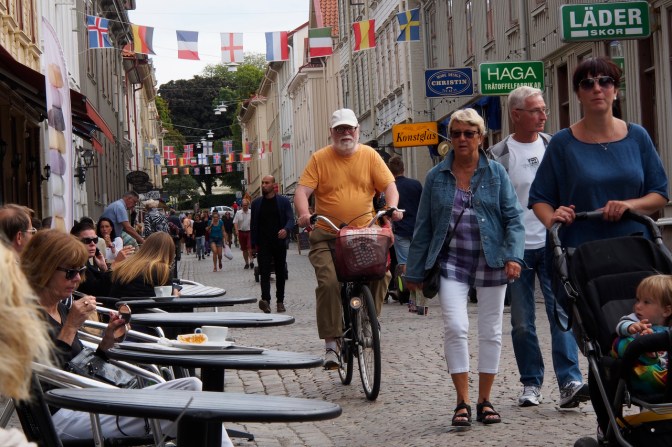
In the morning, we retraced our route back into the city to have a look around. Göteborg is a great cycling city. Separated bike lanes with their own traffic lights make for safe and easy cycling.

Car traffic has to yield to cyclists where the bike lanes cross car lanes or when cars want to turn right across a bike lane. It is amazing how different the cycling experience is when you don’t constantly have to be on your guard for motorists.

After a few hours exploring we headed south on one of the national Swedish cycling routes, the Ginstleden down the west coast. Our entire route out of the city was on separated bike lanes. Very relaxing to ride like that. The route was well signed and easy to follow.

The Swedish west coast route through Halland is a lovely ride on bike paths, small lanes and local roads. It meanders through farm land, along beaches and through forests.
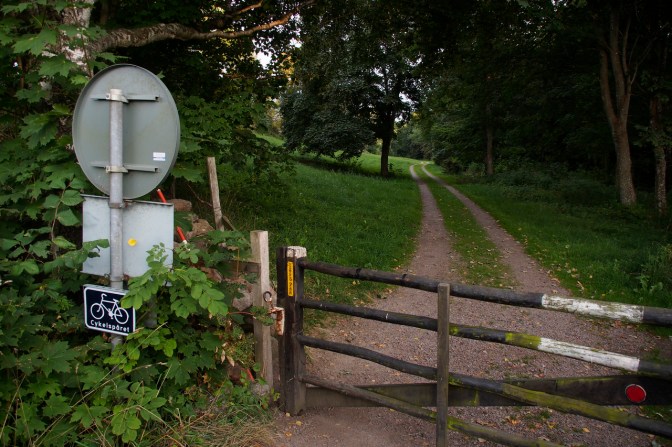
Other cycling routes intersect from time to time and there is a concerted effort between adjoining countries to integrate respective cycling routes to create long-distance routes that span several countries. The North Sea Route is one such example. It runs through Norway, Sweden, Denmark, Germany, The Netherlands and Great Britain. But there are other examples: the Baltic Sea Route, Berlin to Copenhagen, the Danube route and the Rhine route to name a few.

We camped in a sea-side campground with the name Ugglarp after cycling almost 100 KM. The cycling was easy. Flat and no cars to worry about so the miles flew by.
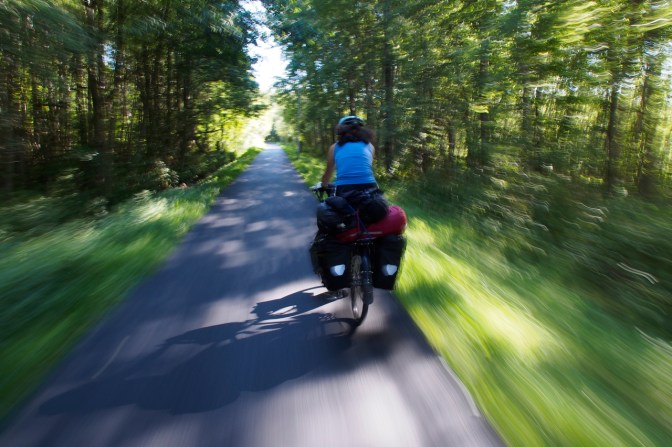
After having been in Norway for nearly two months, a visit to a Swedish grocery store was a treat. For some reason, the richest country in Europe doesn’t nearly have the selection of food available in its shops than its poorer neighbours. A Swedish grocery store was a treat and, as a result of option paralysis, the shopping took a little longer. The prices were also noticeably lower.

Our journey continued south along the coast to Båstad, a little resort town that had kind of shut down as the summer holidays for most Europeans were over. We sat on a nearly empty terrace to have a beer and watched the sea gulls and crows hanging around, looking for any scraps.

We loaded up on some groceries and headed south across a peninsula climbing a few hundred metres and a great run down the other side toward Vejbystrand where we looked for a place to camp. No camp grounds presented themselves but we found a prime piece of beach just off the bike path that had a washroom with running water nearby. It was after 7 and we had cycled 100 KM so it was time to stop.

As we’re pitching the tent, a gentleman walked over and told us that we could not camp there as we were in a nature reserve. We explained that we had not seen a ‘no camping’ sign so we thought it would be okay. But he showed us on a sign, written in tiny Swedish, that it was forbidden to camp in a nature reserve.

He pointed us to a spot about two kilometres north where he said there is a shelter, a toilet and water. We packed up and headed out to find the place. It is a free camp site that is part of a network of such sites along 1,000 KM of coast line in Sweden. Denmark has similar sites along walking and cycling trails. This, along with the Right of Public Access, allows you to camp just about anywhere (except in a nature reserve) as long as you leave the place as you found it and don’t disturb anyone.

We found the spot in no time and didn’t even bother setting up the tent. We made our beds in the shelter, a basic hut with a platform, three walls and a roof. There was fire wood so we made a little fire and cooked our dinner in the dark as by now the sun had long since set. It turned out to be one of the nicer places we have camped.

In the morning we had our breakfast in the shelter while a rain storm passed over and after things had cleared up we headed down the road toward Helsingborg. From there a ferry took us across Øresund to Helsingor in Denmark where we picked up the Danish national cycle route No. 9 along the coast through little seaside towns and resorts to one of Europe’s cycling meccas: Copenhagen.

We arrived in Copenhagen during rush hour and that means lots of bicycles. So many bicycles, in fact, that it became obvious that Copenhagen needs to do some serious infrastructure work to bring its cycle path network up to par with the demand. There are so many cyclists on the road that there is hardly room to move. People whiz by on all sides which can be pretty unnerving for a tourist who is looking around trying to find her way in a new city.

That said, the system does work quite well. Bike lanes with their own traffic lights and left turn lanes. You just have to learn the rules, and quickly if you want to escape unscathed. Check out this site about all things cycling in Copenhagen: www.copenhagenize.com (It’s also on the Links page)

We navigated by GPS to Frank and Lindsay’s place who received us warmly. We met Frank and Lindsay in Iceland a couple of months ago on Canada Day. They are from Vancouver but live in Copenhagen where Frank works and Lindsay is attending university. It was great to see them again and have some local guides in one of Europe’s capitals.

They were very generous with their space and time as they set us up in their spare bedroom and spent two days showing us around Copenhagen by bicycle. It was a great weekend spent with new friends. I’m sure our paths will cross again.

This is one of the things so neat about this trip: meeting new friends, especially other cyclists, because you immediately have something in common. While in Copenhagen, Lindsay convinced us to cycle from there to Berlin. There is a cycle route, the B-KO, which follows national and regional cycle routes in both Denmark and Germany. We would make our own route through Denmark following national and regional cycling routes as we wanted to visit some other friends we met along the way who live west of Copenhagen.
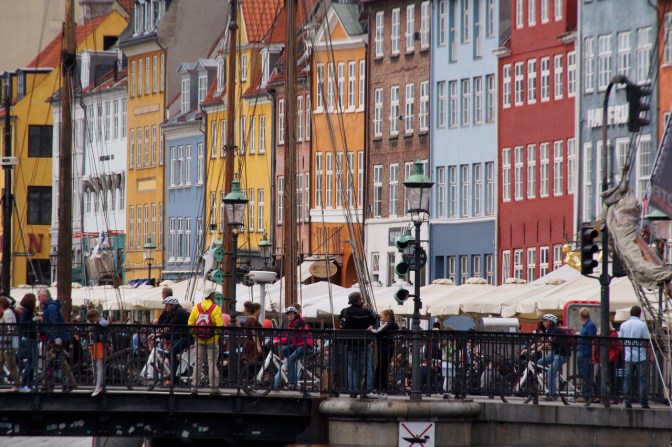
After saying farewell to Frank and Lindsay, we headed west out of Copenhagen towards a small town called Søstrup where Stephan and Thilde live with their two daughters, Antonia and Lara. We met them at Nordkapp in Norway and they invited us to visit, so we took them up on their offer.

Antonia gave up her room for a night so we had a place to sleep and they cooked us a fantastic dinner. Again, great hospitality we so very much appreciate and we hope to repay it some time.
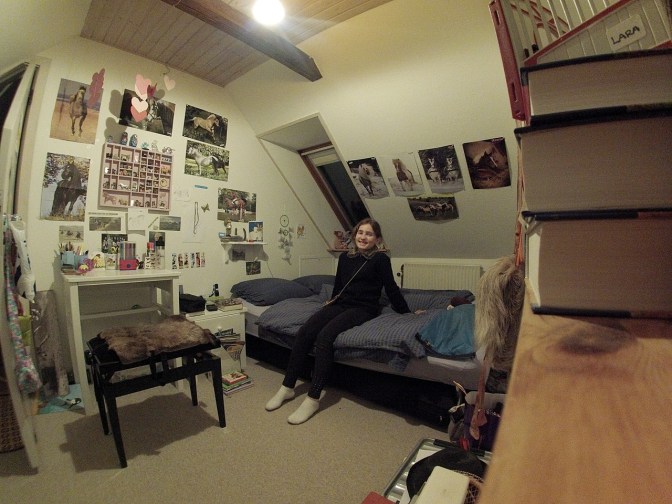
We spent the next two days cycling south through the Danish country side of the island of Falster to the port of Gedser where we boarded the ferry to Rostock, Germany. Rostock was a Hanseatic trading centre in its heyday (c. 13th to 17th centuries) and some of the old buildings there attest to the money that was present in that city. After World War II it became part of East Germany until reunification in 1990. If interested in more info, read this: http://en.wikipedia.org/wiki/Hanseatic_League

Just outside Rostock we were stopped by a gentleman who was cycling with a large group of people. Turns out he was a reporter for an online paper and following along with the group on a ride to check out the condition of the B-KO who was to make recommendations to city council for improvements to the cycling route. We made the news again: http://www.das-ist-rostock.de/artikel/49488_2013-09-08_da-koennen-wir-noch-etwas-tun/
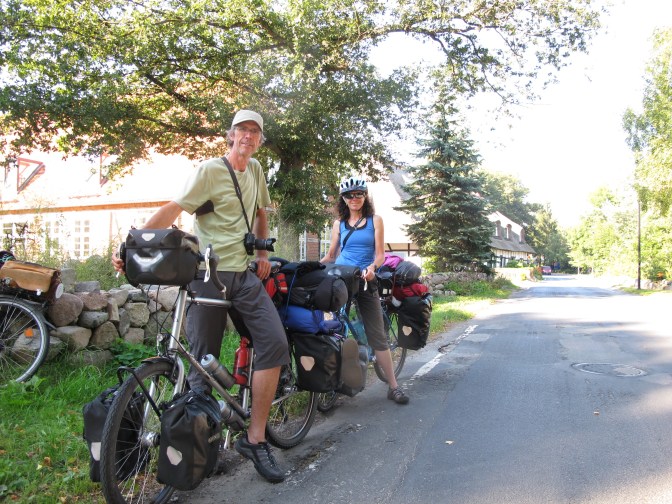
After leaving Copenhagen, the weather improved dramatically. We cycled under blue skies with temperatures in the mid to high twenties, and since the terrain is pretty flat, the kilometres rolled under the wheels quickly and easily. We are doing about 100 KM per day now. In hilly Norway that just wasn’t in the cards for us. Too much gear (weight) on the bike and too many mountains to climb.
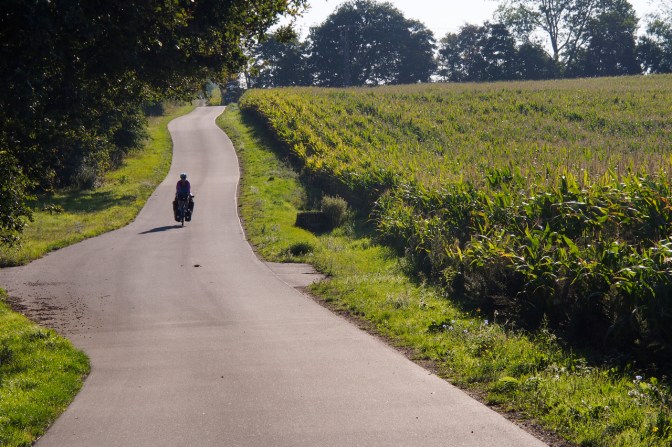
Germany presents another dramatic drop in food costs for us. It’s amazing what 20 Euros will buy, compared to what we’ve been paying for food in Scandinavia. And the beer, well, this is beer heaven. Half litre bottles for as little as 65 cents ($1) I’m taking this opportunity to try a different one every day. Sometimes two, especially when the weather is hot like it has been. After all, one has to rehydrate.

We cycled south through the German countryside from town to town on relatively flat terrain. The route is well signed and easy to navigate. Campsites are plentiful and much cheaper than in Scandinavia. Ten to 12 Euros is a pretty standard fee at campgrounds. Wild camping is not really an option in Germany as it seems to be forbidden, despite many, many opportunities where the camping would be very fine.

The cycling is very nice. Easy. Relaxing. Little or no car traffic to worry about but not a whole lot to look at. Mostly forest and corn fields. After some of the jaw-dropping scenery in Norway, our expectations may be somewhat high, however, the road to Berlin was lined with beer and currywurst which goes a long way.

A day from Berlin, we met up with Sven Duschka, a fellow cyclist we met near Nordkapp in Norway a couple of months earlier. We put his photo and a link to his blog in an earlier post. He had just arrived back to his home near Berlin after a 131-day cycling tour, covering 13,568 KM, through Germany, the UK, Norway, Sweden, Finland, Estonia, Latvia and Lithuania. It was nice to meet him again. He cycled with us for half a day until we got to a campsite at a marina in Liebenwalde, about 70 KM northwest of Berlin.

We are eating out a bit more as restaurants are on the cheap side and the portions are very generous. It’s been a bit difficult figuring out what it all means when reading the menu and talking to the servers who often don’t speak much English, but we’re getting by with Paul’s German, buried deep somewhere in the reptilian part of his brain, and his Dutch, which has a lot in common with German.

As it happens, our friend Dina just moved to Berlin and we have been warmly received. She just started a new job here and has sub-let a nice apartment in Schöneberg, just outside the centre of Berlin. It’s a vibrant neighbourhood with lots of small shops and many restaurants. It’s multi-cultural and the place has a good feel to it.

We have been walking and cycling around Berlin taking in the sights: The Wall (what’s left of it), Checkpoint Charlie, the Brandenburg Gate and the Reichstag.

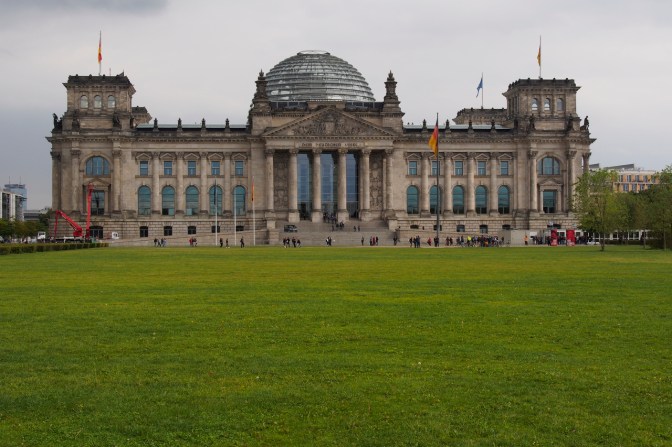
Some of the museums and exhibits deal with Nazi era and the atrocities that happened during that time, as well as the equally atrocious events under the communist regime following the war. One of the exhibits we looked at was on Wilhelmstraße at Topography des Terrors. It’s on the site of the former SS headquarters. The exhibit Berlin 1933: The Path to Dictatorship covers the months in that year when things changed rapidly in Germany and the Nazi party came into power under the dictatorial leadership of Adolph Hitler, setting the stage for World War II.


On the lighter side, we went on a shopping expedition to one of the largest bicycle stores ever. This store was the size of a Costco and full of every imaginable kind of bicycle and bike part, but not quite all the parts we needed, unfortunately. But that too shall be resolved somehow.
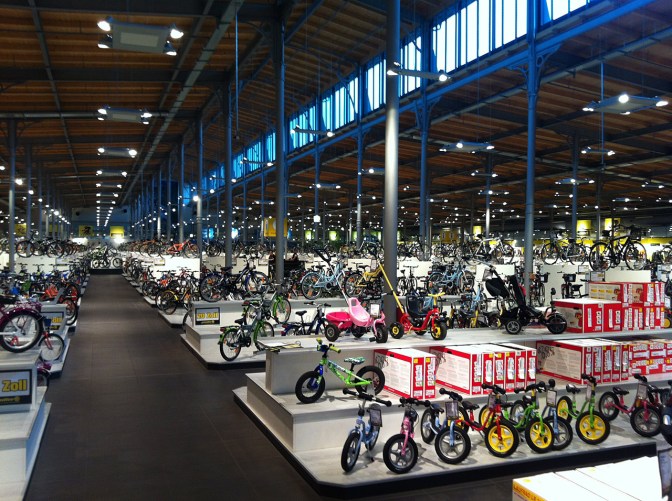
We will carry on through Germany but have not yet sorted out which way. One thing is sure: we will go to Tübingen to visit our friend Tom who will help us get the bikes in shape again. Stay tuned.

Fun fun fun!
Walt and Paul are on the same page with the beer tasting!
Amazing – that beer sampler looked like a bit of heaven, but then so do all the scenes you’ve shared! Hi from NOWland!
Boy that bike store is amazingly huge. Glad you enjoyed the bike routes in Sweden, Germany, etc.
Hi there, looks like a great trip! I came across your blog googling the trip from gothenburg to copenhagen, which I plan to cycle next month. Just wondering do you have any more information on where the shelter near Vejbystrand is?
Hi Leonora, here are the coordinates: N56 20.319 E12 44.801
Copy them into Google Maps and you will get the location. It was a great place to camp. Enjoy.
thank you (: